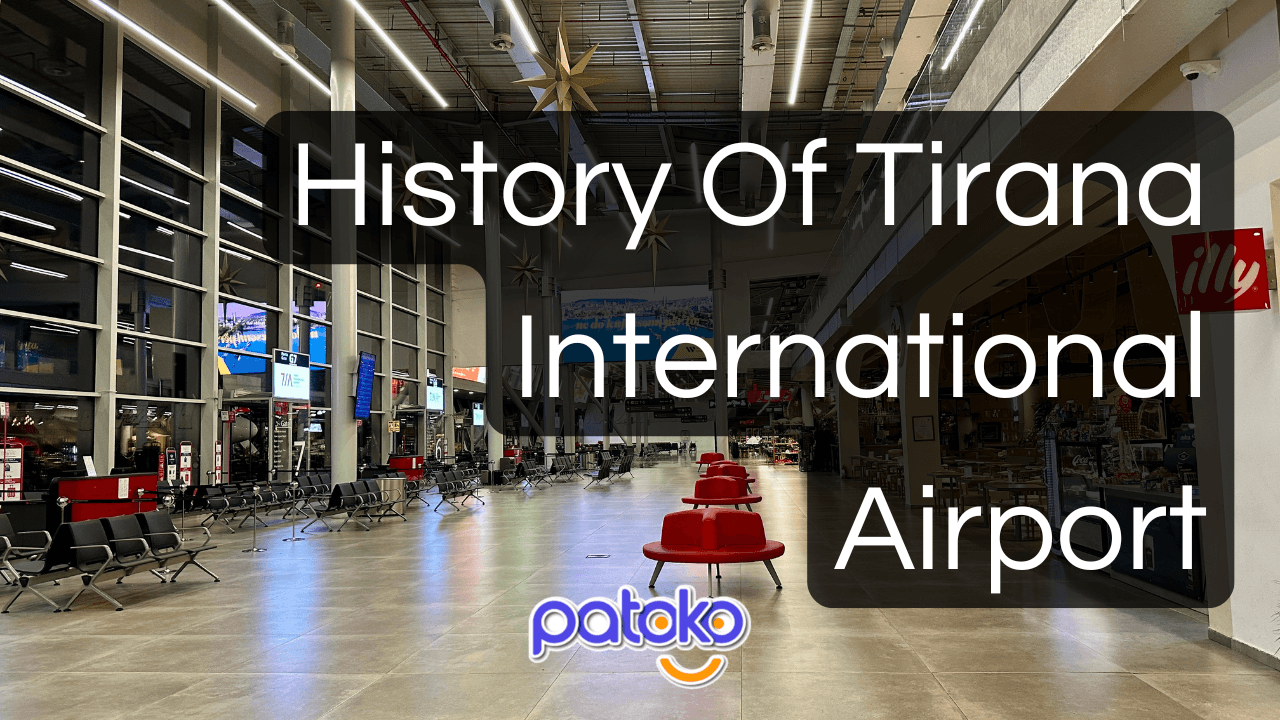Take a Taxi With Patoko Today
Use "WEB" referral code, for a free 50 Toko bonus.

Explore the history, growth, and modernization of Tirana International Airport (Rinas) as Albania's vital air hub, connecting Rinas to key global destinations.
Use "WEB" referral code, for a free 50 Toko bonus.
Tirana International Airport Nënë Tereza (TIA) (IATA: TIA, ICAO: LATI), also known as Rinas International Airport, stands as Albania’s sole international airport (with another coming soon in Vlore) and serves as a vital transportation hub for both the country and the broader Balkan region. The airport’s mission is to “provide Albania with a prestigious international aviation facility offering efficient, safe, and first-class service for passengers and airlines”. Since being renamed after Mother Teresa in 2001, the airport has undergone a remarkable transformation since its construction in the mid-20th century, changing from a modest facility to a sleek HQ connecting Albania to a network of international routes.
Just landing? Click here for a guide on Arriving at TIA and getting into Tirana. If you’re after a transfer, let us know.
Looking to get to TIA? Try this one.
Disclaimer: The information presented here is based on publicly available data and records we could locate. If there are historians, scholars, or aviation experts with additional insights or corrections, we would love to hear from you to enrich this historical overview. While we strive for accuracy, we acknowledge that historical records can sometimes be incomplete or contain discrepancies. Different sources may present varying accounts, and we do not guarantee the complete accuracy of all information presented. This content should be considered a general overview rather than definitive historical documentation.
Tirana’s history with commercial air travel predates the construction of the current airport. Domestic aviation in Albania commenced in 1926 when the German airline Adria-Aero-Lloyd secured exclusive rights to operate domestic air routes. The airline initiated flights connecting Tirana to Shkodër, Korçë, and Vlorë, but these operations proved unsustainable. By 1935, the Italian company Ala Littoria acquired operational rights, establishing regular routes to Albanian cities such as Kukës, Peshkopia, Kuçova, Vlorë, and Gjirokastër (source).
Following World War II, Albania resumed its aviation efforts in 1955 with the inauguration of a route to Moscow, marking the start of connections to Eastern European capitals.
Tirana’s strategic importance grew during the 1970s when it became one of the first European cities served by China’s CAAC Airlines with a weekly flight to Beijing via Bucharest and Tehran. By the late 1980s, TIA saw operations from six airlines managing nine round-trip flights per week.
The fall of communism in 1991 was a major moment in Albania’s aviation industry. Travel restrictions were lifted, leading to a surge in demand for air travel. By 1999, TIA was handling 8,249 flights and over 356,000 passengers annually—a sevenfold increase compared to 1991 (source).
To give some additional context, we were able to find this video, uploaded in March of 2007. The airport structure and signage continues to look similar in 2024.
Tirana International Airport has undergone several name changes throughout its history, which can occasionally present confusion when speaking with people from different parts of the world.
The modern TIA terminal, designed by architect Hin Tan, includes:
As part of its sustainability initiatives, TIA plans to install photovoltaic panels generating 49 MW of energy and expand the use of electric ground vehicles. These efforts align with global trends toward reducing the carbon footprint of airports.
TIA has experienced significant growth in passenger traffic over recent years. The following data is sourced from a few recent reports:
| Month/Year | Passengers | Growth Rate (%) |
|---|---|---|
| October 2024 | 936,521 | 46% |
| Year-to-Date (2024) | 9.26 million | 54% |
Recent data for the month of October 2024 reveals notable changes in passenger volume across key destinations:
TIA is often referred to as “Tirana Rinas” due to its location in Rinas, a village approximately 11 kilometers (6.9 miles) northwest of Tirana. The name “Rinas” has been in use since the airport’s early days and remains a preferred term among locals and frequent travelers, emphasizing its deep ties to the surrounding community (source). When taking a Taxi or bus, you may find success using this terminology.
From its beginnings in the 1950s to its recent status as a modern airline hub, Tirana International Airport has played an important role in connecting Albania to the world. With sustained investments, innovation, and a commitment to excellence, TIA is sure to remain a key driver of Albania’s economic and tourism development for years to come.